by Heather Kent | Jul 28, 2022
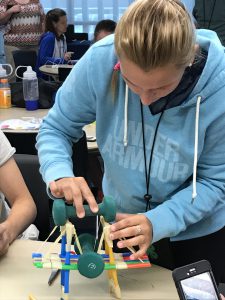 Whether you are a teen helping with a day camp, or an adult leading a club- it helps to have some tips and tricks in your back pocket to teach the content you want 4-H members to learn. 4-H volunteers and professionals often find themselves teaching a wide variety of audiences with different needs for learning. Trying to meet all those needs can sometimes seem overwhelming, but this week and next, our blog will focus on six specific strategies that will make this much easier- especially with practice! This blog post will discuss and give examples of three teaching strategies that can up your teaching and facilitation game- spacing, interleaving, and retrieval practice.
Whether you are a teen helping with a day camp, or an adult leading a club- it helps to have some tips and tricks in your back pocket to teach the content you want 4-H members to learn. 4-H volunteers and professionals often find themselves teaching a wide variety of audiences with different needs for learning. Trying to meet all those needs can sometimes seem overwhelming, but this week and next, our blog will focus on six specific strategies that will make this much easier- especially with practice! This blog post will discuss and give examples of three teaching strategies that can up your teaching and facilitation game- spacing, interleaving, and retrieval practice.
Why Bother? Isn’t the 4-H Curriculum “Good Enough?”
Some 4-H curricula have teaching strategies embedded within them. Some just have activities structured to help youth learn content. Learning and applying a few of these teaching strategies will make your teaching more interesting and engaging to a wider range of 4-H members. Engagement + interest = more fun for everyone!
Spacing
The term “spacing” simply means to spread learning out over time. When information is learned over the course of several weeks, months, or even years, youth (and adults) are more likely to retain that information than if it were dumped on them over several hours or days. This is why 4-H projects are so effective- youth often stay with the same project for one or more years, learning more complex information each year until they have mastered the content. Some project work even leads to future careers.
Here is an example of how you might apply spacing to the youth you work with in 4-H: One of the things youth want to do this year is participate in the Consumer Choices contest. Rather than teaching a marathon Saturday workshop the week before the contest, start early and introduce the concepts slowly either as part of a club meeting or an extra session before or after the regular club meeting time.
- Meeting #1- Explain why consumer skills are essential, what the topics for this year’s contest are, and the contest rules
- Meeting #2- Review cell phone plans and portable speakers (two of the topics). Demonstrate how to fill out a judging card and practice judging situations for cell phone plans and speakers.
- Meeting #3- Review ground transportation and smoothies (two more topics). Review how to fill out a judging card and practice judging situations.
- Meeting #4- Explain what oral reasons are- have an older youth demonstrate or what videos of youth giving oral reasons. Next, hold a mock contest and let youth practice giving oral reasons.
Interleaving (not to be confused with interweaving)
Interleaving means switching between topics. This allows youth opportunities to practice life skills in different situations. This helps reinforce the life skills that we teach in 4-H. For example, judging contest strategies are the same- it’s just the content that changes from contest to contest. Judging contests help youth learn about different topics, but the real value is they are learning how to think critically, communicate clearly, and work as a team. Applying those same skills to different subject matter helps youth learn lifelong skills (not just how to regurgitate facts). Here’s an example of interleaving that builds on the consumer choices example above:
The youth you work with will also want to learn about robotics, so you introduce an activity from the 4-H Junk Drawer Robotics curriculum. You divide the youth up into groups of three to complete a challenge to build a robot that draws. While teaching, refer back to what youth learned about critical thinking when they competed as a team in consumer choices. What did they learn about communication and teamwork? Ask them to apply those lessons to this situation when building a robot.
Retrieval Practice
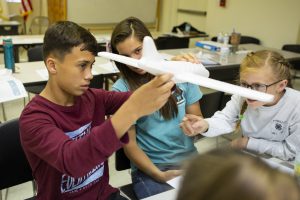
4H youth work together in a drone course. Photo taken 10-15-18.
One of the best ways to strengthen your memory is to practice retrieving that information from your brain! Many of our 4-H curricula include games that allow youth to practice information retrieval. Quiz bowls and skill-a-thon stations are two great ways to incorporate retrieval practice. Here is an example of retrieval practice that builds upon the consumer choices example:
Youth enjoyed participating in the consumer choices contest and asked if they could do more activities like that. Your local 4-H agent suggested a program called “Living on My Own” which is a financial simulation that helps teach financial literacy skills. As the youth rotate through the stations, they retrieved and practiced some of the consumer skills they learned earlier as they decided on housing, transportation, food, and other items based on their simulated salary and living situation. Being about to recall and practice these skills helps reinforce financial literacy.
One of the best things about 4-H is it is learner-centered. That means that youth can choose what they want to do and learn in 4-H. Your local 4-H Extension Office can help you find the best curriculum to support your youths’ learning needs, but the curriculum is only part of learning. 4-H supports learning (usually referred to as a project) through a variety of competitive and non-competitive events. The three strategies described in this post can help volunteers and 4-H professionals link learning between projects and activities. Next week’s post will explore three more strategies for teaching youth- elaboration, concrete examples, and duel coding.
References:
- Potter, S. (2021). Educational Design and Delivery – Utilization of Multiple Teaching Strategies. 4-H VKRC Fact Sheets.
- Weinstein, Y., Madan, C. R., & Sumeracki, M. A. (2018). Teaching the science of learning. Cognitive Research: Principles and Implications, 3, 2. https://cognitiveresearchjournal.springeropen.com/articles/10.1186/s41235-017-0087-y
- Weinstein, Y, Sumeracki, M & Caviglioli, O (2019) Understanding how we learn: A visual guide. Routledge, Abingdon, Oxon, UK.
by Heather Kent | Jul 5, 2022
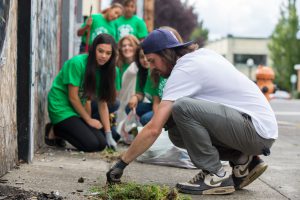 In a recent study, one of the top things 4-H volunteers are looking for are ideas for adapting activities to different age groups (Kent, 2022). Florida 4-H offers experiences for four different age groups: Cloverbuds (ages 5-7), Juniors (ages 8-10), Intermediates (ages 11-13), and Seniors (ages 14-18). One of the great things about 4-H is that the whole family can participate! This also means that 4-H volunteers often find themselves working with a variety of age groups. That might seem a little overwhelming, but this post series gives practical tips and strategies to make it less daunting. This week’s post is focused on adapting activities for intermediate-age 4-H members. In case you missed it, check out the previous couple of weeks’ posts to learn about cloverbuds, juniors, and intermediates.
In a recent study, one of the top things 4-H volunteers are looking for are ideas for adapting activities to different age groups (Kent, 2022). Florida 4-H offers experiences for four different age groups: Cloverbuds (ages 5-7), Juniors (ages 8-10), Intermediates (ages 11-13), and Seniors (ages 14-18). One of the great things about 4-H is that the whole family can participate! This also means that 4-H volunteers often find themselves working with a variety of age groups. That might seem a little overwhelming, but this post series gives practical tips and strategies to make it less daunting. This week’s post is focused on adapting activities for intermediate-age 4-H members. In case you missed it, check out the previous couple of weeks’ posts to learn about cloverbuds, juniors, and intermediates.
What are “Ages & Stages” and Why Does it Matter?
“Ages & stages” is a phrase commonly used in youth development that refers to the physical, social, emotional, and cognitive development of a young person. These categories of development are based on the work of researchers such as Piaget and Erickson. Understanding these categories help 4-H volunteers and professionals provide opportunities for youth to thrive through social and emotional learning and is a key part of the 4-H Thrive Model (Arnold & Gagnon, 2020). There are several benefits of selecting (or adapting) age-appropriate activities for youth:
- First, it makes learning fun! Fun is important; boring is bad.
- Youth are more engaged. When activities are not too challenging or too easy, they are in what’s called the “zone of proximal development,” or ZPD (Vygotsky, 1978). This is key to helping learners master new skills. ZPD refers to skills or knowledge that are too difficult for a youth to master on their own, but possible to master with guidance from a more knowledgeable person- like their 4-H volunteer!
- Youth can build on past learning experiences and create future opportunities to grow.
- When learning is fun and youth are engaged, youth stay involved in 4-H!
How to Use “Ages & Stages” to help Seniors Thrive
Social Development of 14-18 year-olds (how they act)
Youth who are 14-18 years old continue to establish a strong sense of self. They enjoy opportunities to work together as a team and develop strong friendships. They are also developing social networks and beginning to think more seriously about their future. 4-H is a great way for youth in this age group to prepare for life beyond high school by fine-tuning interview and communication skills and building a network of friends and adults that have the same interests as theirs.
| Typical social behaviors for 14-18-year olds include: |
Strategies for supporting the social development of
14-18 -year olds |
- Developing their self-identity – what makes them unique
- Continues to want more freedom from parental control and the power to make some of their own decisions
- Still likes to participate as a member of a group but is now aware of and exploring the different roles, especially that of a mentor or teacher for younger youth.
- Seeks peer group acceptance like before, plus now, status matters
- Understands the benefits of sharing and working together.
|
- Provide opportunities to share, learn and explore people’s different values, abilities, uniqueness, etc. so they can begin to identify their own
- Continue to give youth the opportunity to plan, implement and evaluate 4-H activities.
- Encourage youth to take on leadership roles and mentor younger youth
- Foster a sense of belonging in which youth are accepted, encouraged, and supported by their peers.
- Provide opportunities for youth to create groups and decide which groups they want to be in
- Build-in or plan for opportunities where youth can recognize each other’s accomplishments
|
Cognitive Development of 14-18-year-olds (how they think)
Youth that are 14-18 -years old can think logically and apply abstract reasoning, so problem-solving and critical thinking are a way to help youth in this age group learn. One of the best ways for youth in this age group to demonstrate mastery is by teaching younger youth. Many of our project areas have opportunities for older youth to serve in a “teens as teachers” role. Another way to engage older youth is in district and state leadership positions. Florida 4-H offers several opportunities for teens to plan district and statewide events through District Council and State Executive Board. Youth in this age group will also be interested in using their problem-solving and critical thinking skills to compete at the National levels in their project area.
| Typical learning behaviors for 14-18 -year olds include: |
Strategies for Supporting Cognitive Development
of 14-18-year olds: |
- Enjoys exploring ideas and these can be abstract or virtual
- Learns best when new ideas are linked to their interests
- Able to multi-task
- Able to mentor and teach younger youth
- Able to plan a whole event- especially at the District or State level
- Can apply critical thinking and problem-solving skills to National Contest opportunities.
|
- Engage teens in District and National activities, teams, projects, etc.
- Encourage teens to demonstrate mastery in their project work by teaching or mentoring younger youth with similar interests.
- Empower teens to lead and plan a wide range of activities, encouraging them to be creative and put their own “twist”
|
Throughout this series, we have been using examples from each of the three pillar programs in 4-H: Citizenship & Leadership, Science, and Healthy Living. These examples are meant to help parents and volunteers see how an activity can be adapted for each of the different age groups. For examples for other age groups, check out our previous posts about Cloverbuds, Juniors, and Intermediates.
- Citizenship & Leadership: For citizenship & leadership, we have been using the example of a 4-H club business meeting. Fourteen to 18 year olds are going to be more interested in learning about leadership roles beyond the club and county level- encourage them to run for a district or state office, or serve on a statewide planning committee for a 4-H event. Youth in this age group might also be interested in participating in the 4-H Citizenship Washington Focus to learn more about leadership and government at the national level.
- Science: For science, we have been using the 4-H entomology project as an example. Entomology is the study of insects. Youth that are 14-18 can help lead the entomology project at the county level and compete 4-H Insectathon contest to earn a college scholarship. Encourage youth to participate in a 4-H University track to learn more about careers in Entomology. Youth may also want to participate in the National 4-H Agriscience Summit.
- Healthy Living: For Healthy Living, we have been using the 4-H personal wellness project as an example. This project area helps youth learn about nutrition, physical fitness, and mental health. For seniors, they can teach a workshop on personal wellness at 4-H Teen Retreat, or apply for Community Pride funds to address a problem related to personal wellness. 4-H seniors would also be interested in attending the National 4-H Healthy Living Summit.
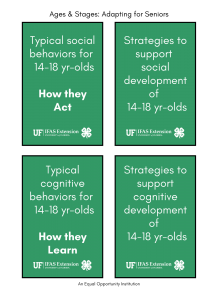 Using the “Ages & Stages” approach with youth reinforces the Essential Elements of 4-H: Belonging, Mastery, Independence, and Generosity. This is also key to helping youth thrive. However, each individual youth grows at their own pace and might not completely meet the general tendencies listed above. As volunteers and 4-H professionals, it is important to observe youth and meet them where they are physically sociality, and intellectually. Adapting activities on the fly gets easier with practice- download this set of flashcards for a quick reference guide. You can print them, cut them out, and punch them to fit on a lanyard as a handy teaching aid. Your local 4-H agent is always available to help and provide additional resources if you have questions.
Using the “Ages & Stages” approach with youth reinforces the Essential Elements of 4-H: Belonging, Mastery, Independence, and Generosity. This is also key to helping youth thrive. However, each individual youth grows at their own pace and might not completely meet the general tendencies listed above. As volunteers and 4-H professionals, it is important to observe youth and meet them where they are physically sociality, and intellectually. Adapting activities on the fly gets easier with practice- download this set of flashcards for a quick reference guide. You can print them, cut them out, and punch them to fit on a lanyard as a handy teaching aid. Your local 4-H agent is always available to help and provide additional resources if you have questions.
References:
- Arnold, M. E. & Gagnon, R. J. (2020). Positive youth development theory in practice: An update on the 4-H Thriving Model. Journal of Youth Development, 15(6), 1-23.
- Erikson, E. H. (1963). Childhood and Society (2nd Ed.). New York: Norton.
- Kent, H.C. (2022). Informal learning to support volunteer performance. [Unpublished doctoral dissertation]. Florida State University.
- Lee, F. and Go, C. (2002). Developmental stages. UC ANR 4-H Youth Development Program.
- Piaget, J. (1971). The theory of stages in cognitive development. In D. R. Green, M. P. Ford, & G. B. Flamer, Measurement and Piaget. McGraw-Hill.
- Pleskac, S. (2000). Educational design and delivery: Use of age-appropriate activities. VRKC fact sheet.
- Vygotsky, L. S. (1978). Mind in society: The development of higher psychological processes. Cambridge, MA: Harvard University Press.
by Heather Kent | Jul 3, 2022
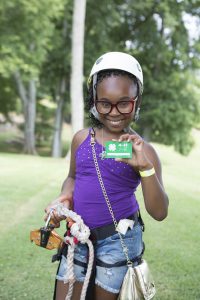 In a recent study, one of the top things 4-H volunteers are looking for are ideas for adapting activities to different age groups (Kent, 2022). Florida 4-H offers experiences for four different age groups: Cloverbuds (ages 5-7), Juniors (ages 8-10), Intermediates (ages 11-13), and Seniors (ages 14-18). 4-H encourages family involvement and engagement, and volunteers often find themselves working with a variety of age groups. That means that often, volunteers find themselves adapting activities on the fly to meet the needs of each youth. That might seem a little overwhelming, but this post series gives practical tips and strategies to make it less daunting. This week’s post is focused on adapting activities for junior age 4-H members. In case you missed it, check out last week’s post on adapting activities for Cloverbuds. This post also includes free downloadable flashcards as a handy reference tool!
In a recent study, one of the top things 4-H volunteers are looking for are ideas for adapting activities to different age groups (Kent, 2022). Florida 4-H offers experiences for four different age groups: Cloverbuds (ages 5-7), Juniors (ages 8-10), Intermediates (ages 11-13), and Seniors (ages 14-18). 4-H encourages family involvement and engagement, and volunteers often find themselves working with a variety of age groups. That means that often, volunteers find themselves adapting activities on the fly to meet the needs of each youth. That might seem a little overwhelming, but this post series gives practical tips and strategies to make it less daunting. This week’s post is focused on adapting activities for junior age 4-H members. In case you missed it, check out last week’s post on adapting activities for Cloverbuds. This post also includes free downloadable flashcards as a handy reference tool!
What are “Ages & Stages” and Why Does it Matter?
“Ages & stages” is a phrase commonly used in youth development that refers to the physical, social, emotional, and cognitive development of a young person. These categories of development are based on the work of researchers such as Piaget and Erickson. Understanding these categories help 4-H volunteers and professionals provide opportunities for youth to thrive through social and emotional learning and is a key part of the 4-H Thrive Model (Arnold & Gagnon, 2020). There are several benefits of selecting (or adapting) age-appropriate activities for youth:
- First, it makes learning fun! Fun is important; boring is bad.
- Youth are more engaged. When activities are not too challenging or too easy, they are in what’s called the “zone of proximal development,” or ZPD (Vygotsky, 1978). This is key to helping learners master new skills. ZPD refers to skills or knowledge that are too difficult for a youth to master on their own, but possible to master with guidance from a more knowledgeable person- like their 4-H volunteer!
- Youth can build on past learning experiences and create future opportunities to grow.
- When learning is fun and youth are engaged, youth stay involved in 4-H!
How to Use “Ages & Stages” to help Juniors Thrive
Social Development of 8-10 year-olds (how they act)
Youth who are 8-10 years old are learning how to be competent at activities valued by adults or their peers. When they struggle with competence, it is easy for them to feel inferior. It is best not to compare one youth to another. Instead, focus on how youth improve over time. Use the “oreo” method to compliment them on something they do well, then give them some constructive feedback, followed by another compliment.
| Typical social behaviors for 8-10-year-olds include: |
Strategies for supporting social development of 8-10-year-olds: |
- Participates as a member of a group and contributes to the group effort
- Still prefer same-gender friendships of short duration, often moving from one friend group to another
- Peer group acceptance is important
- Understands and practice sharing
|
- Help youth identify “what they are good at.” This ties in really well with sparks to create a strong environment for positive youth development
- Focus on helping youth achieve their personal best, such as comparing this month’s archery score with last month’s score. Avoid comparing youth to each other.
- When working with mixed-gender groups, provide opportunities for same-gender activities
- Encourage youth to recognize peers’ accomplishments, not just their own.
|
Cognitive Development of 8-10-year-olds (how they think)
Youth who are 8-10 years old are beginning to learn how to think more abstractly. They can now think in terms of cause and effect and understand the logic behind concrete events. They are also beginning to be able to “see” mental representations of ideas or concepts, such as the water cycle.
| Typical learning behaviors for 8-10-year-olds include: |
Strategies for Supporting Cognitive Development of 8-10-year-olds: |
- The attention span of about 40 minutes
- Likes to explore ideas especially if related to a hands-on or concrete experience
- Can do simple multi-tasking
- Learns best when new ideas are related to a piece of previous knowledge or experience
- Understands reasons behind right and wrong and can apply it
- Able to develop simple plans
- Beginning to understand give and take
- Interest expands beyond the home to extend to neighborhood and community
- Beginning to see people as individuals with unique thoughts, ideas, beliefs, and values
|
- Continue to keep youth engaged by using different teaching methods (e.g., hands-on, watch a video, pair off, etc.)
- Start your activities with the hands-on experience as much as possible, and keep instructions simple and brief
- Present a new idea or activity by referring to things that the youth already know such as “last month we learned about different types of horse feed. This month we are going to learn about the digestive system of a horse by building a model”
- Avoid telling youth about right or wrong, instead, ask them why this could be right or wrong…
- Engage youth in planning but set reasonable expectations – do not expect them to plan a whole event.
- Use community service opportunities to help youth learn about their neighborhood
- Engage youth to share their family traditions, customs, values, etc.
|
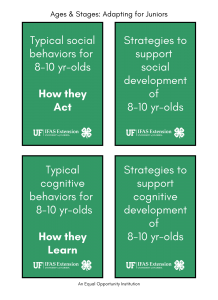
Examples of Ages & Stages Applied for Juniors
Throughout this series, we have been using examples from each of the three pillar programs in 4-H: Citizenship & Leadership, Science, and Healthy Living. These examples are meant to help parents and volunteers see how an activity can be adapted for each of the different age groups. For examples for other age groups, check out our previous post about Cloverbuds.
- Citizenship & Leadership: For citizenship & leadership, we have been using the example of a 4-H club business meeting. Eight to 10-year-olds can follow the club meeting script to begin to learn about the order of a business meeting. You can write a different role on popsicle sticks, then ask youth to draw a role at the beginning of each meeting. Y This way, they begin to learn about leadership roles and the business meeting model without the pressure of needing to know what to say. Eight to 10-year-olds will also want to be involved in committee work, led by an older, more experienced youth or with the help of a parent volunteer. During committee meetings, allow youth to plan parts of club events such as celebrations, fundraisers, or service projects.
- Science: For science, we have been using the 4-H entomology project as an example. Entomology is the study of insects. Eight to 10-year-olds can catch and begin to identify insects using a simple key. They may also want to pin and display their insects at their county or regional fair. They could also team up with a friend and give an illustrated talk or demonstration about what they have learned about insects for their club or county events.
- Healthy Living: For Healthy Living, we have been using the 4-H personal wellness project as an example. This project area helps youth learn about nutrition, physical fitness, and mental health. For juniors, this could be an opportunity for them to explore other cultures through food. Ask different youth to share what their family’s favorite meals are. This is a great way for them to cultivate learning beyond their home to include their neighborhood and community.
Using “Ages & Stages” approach with youth reinforces the Essential Elements of 4-H: Belonging, Mastery, Independence, and Generosity. This is also key to helping youth thrive. However, each individual youth grows at their own pace and might not completely meet the general tendencies listed above. As volunteers and 4-H professionals, it is important to observe youth and meet them where they are physically sociality, and intellectually. Adapting activities on the fly gets easier with practice- download this set of flashcards for a quick reference guide. You can print them, cut them out, and punch them to fit on a lanyard as a handy teaching aid. Your local 4-H agent is always available to help and provide additional resources if you have questions.
References:
Arnold, M. E. & Gagnon, R. J. (2020). Positive youth development theory in practice: An update on the 4-H Thriving Model. Journal of Youth Development, 15(6), 1-23.
Erikson, E. H. (1963). Childhood and Society (2nd Ed.). New York: Norton.
Kent, H.C. (2022). Informal learning to support volunteer performance. [Unpublished doctoral dissertation]. Florida State University.
Lee, F. and Go, C. (2002). Developmental stages. UC ANR 4-H Youth Development Program.
Piaget, J. (1971). The theory of stages in cognitive development. In D. R. Green, M. P. Ford, & G. B. Flamer, Measurement and Piaget. McGraw-Hill.
Pleskac, S. (2000). Educational design and delivery: Use of age-appropriate activities. VRKC fact sheet.
Vygotsky, L. S. (1978). Mind in society: The development of higher psychological processes. Cambridge, MA: Harvard University Press.
by Allison Leo | Apr 29, 2022
Benefits of being recognized
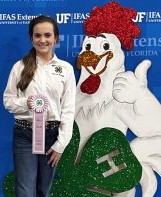
Ways to feel special without food! Youth receiving rosette for a job well done!
One of the most important aspects of working with youth is the relationships that we build with them. Recognition is a basic human need, and in 4-H, recognition of youth members for their knowledge gained and mastery of skills is an important part of our positive youth development program. Using incentives and prizes during a 4-H program can be an effective way to create a sense of belonging. While working with youth, it is important to acknowledge their achievements and hard work throughout the club year.
Using Food as a Reward
Candy and sweets are often used to reward good behavior or accomplishments because kids like them and they are inexpensive. It is tempting to lean towards sweets and candy when selecting rewards and prizes for youth, but when food is given as a reward, children start to connect it to good or bad, and not fuel for the body. Rewarding youth with sweets can contradict the teaching and modeling of behaviors that promote healthy life skills in 4-H. Often, these foods have little or no nutritional value.
Non-food Rewards
Non-food rewards are a great option for acknowledging youth at 4-H club meetings, in school, and while at home. By using non-food rewards to acknowledge behavior, this promotes a healthy environment and helps children develop a healthy relationship with food. Recognizing youth with words of appreciation are better motivators than rewards of food. Telling a child, “I am so impressed with how hard you worked on your project,” is a healthy alternative to giving them candy for their success.
Creating an Inclusive Environment
Non-food rewards also create an inclusive environment for those we have food allergies and cannot partake in many food rewards. The Centers for Disease Control and Prevention’s (CDC) “Voluntary Guidelines for Managing Food Allergies in Schools and Early Care and Education Programs” recommends the “use of non-food incentives for prizes, gifts, and awards.” While a shift to non-food incentives may require slight changes to traditions, there are many potential benefits. Below is a list of free and low-cost reward options to use with kids.
Free
- Certificate
- Lead a game or activity
- Help teach lesson
- Trip to the park
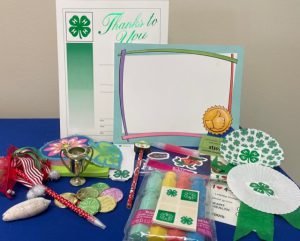
Examples of non food reward items.
- Special privilege at home or club meeting
- Book exchange
Low-cost rewards
- Stickers
- Stress balls
- Notepads
- receive a plant, seeds and a pot for growing
- Pencils
- Art supplies
- Coloring book g
- Glitter
- Bookmarks
- Cupcake Wrapper Rosette
- Small toys
- Stencils
Group rewards
- Bowling party
- Field day
- Movie day
- Trip to a community park
- Canoe or kayak trip
by pmdavis | Apr 22, 2022
Happy Earth Day Everyone! 4-H has a wonderful recycling project for you to do with little ones as an activity for Earth Day. The exciting part is that you will most likely have the materials around your house!
The activity is the creation of a recycled paper pot. This is a great way to start seeds inside to watch them grow. Then, you can transfer the pot and all into the ground when the plant is bigger.
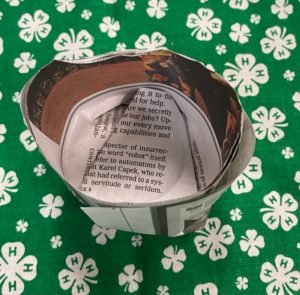
Great way to start seeds and recycle
Of course, you can buy special seed trays. You can recycle old nursery trays and pots if you clean them properly with a mild solution of bleach and water and rinsed well. You can also use disposable cups, or you can sow seeds in old deli trays, rotisserie chicken containers, milk jugs, almost anything that will hold a couple inches of soil.
However, the 4-H paper pot is another fun recycling project that is easy to do. These are biodegradable pots that will last about 6 weeks before they disintegrate. This project is an easy seed starting activity for all ages! It’s a great way to teach responsibility, record keeping, teamwork, and care for living things. Plus, you can save money and resources by making your own paper pots to start your seeds.
For this project, you will need
- Newspaper or other paper cut into strips (not glossy inserts)
- A Container, bottle, can or jar that can be wrapped in paper (not glass)
- Soil
- Seeds
What to do:
- Cut strips of newspaper or regular paper about 4” wide.
- Wrap strip of newspaper around an empty container and roll fairly tight.
- Scoot paper down so the paper will reach the half way point and when folded. It should overlap the open end of the container.
- Fold the ends of the paper against the bottom of the container, starting where the paper meets the on the outside.
- Push the bottom of the container against a flat, hard surface (such as a table) to seal the bottom of your pot.
- Pull the container out and you have a finished paper pot. Fill with soil and plant your seeds.
- When the seedling is ready to transplant, simply drop the entire pot into the ground.
The newspaper will biodegrade in your garden or pot. Your plant will never be uprooted and continue to grow undisturbed. When planted make sure the paper is not sticking out of the ground. If the paper is above ground it will wick water away from the plant.
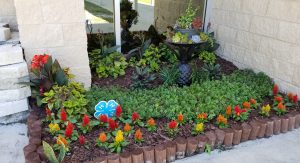
Photo of succulent garden at entry of NSA-PC Youth Center Created by 4-H Garden Club
You can print a PDF version of the instructions for this activity.
Other great gardening resources include:
• Florida Vegetable Gardening Guide
• Florida Planting Calendar by Region
• Florida AG in the Classroom
• Junior Master Gardener Program
If you have a green thumb, consider becoming a 4-H gardening volunteer! 4-H needs caring adults like you to share their knowledge and passion for gardening with the next generation. Through the 4-H gardening project or other environmental focused programs.To get involved, contact your local UF IFAS Extension Office, or visit Florida 4-H. We hope you will consider making the best better with 4-H.
The Institute of Food and Agricultural Sciences (IFAS) is an Equal Employment Opportunity-Affirmative Action Employer authorized to provide research educational information and other services only to individuals and institutions that function without regard to race, creed, color, sex, age, handicap, or national origin. U.S. DEPARTMENT OF AGRICULTURE, COOPERATIVE EXTENSION SERVICE, UNIVERSITY OF FLORIDA, IFAS, FLORIDA A & M UNIVERSITY COOPERATIVE EXTENSION PROGRAM, AND BOARDS OF COUNTY COMMISSIONERS COOPERATING.
by Claire Davis | Feb 11, 2022
Like me, you make ask, what is a “sense of belonging”? Have you ever felt out of place when going to a club, meeting, or gathering? Do you remember how it made you feel? Maybe you were nervous, had a funny feeling in your stomach, a knot in your throat, or weren’t sure if you belonged?
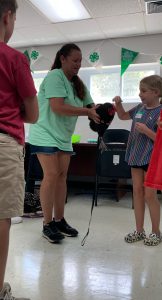
Volunteer working with youth. Calhoun County Animal Science Camp 2021
One of the essential elements of 4-H Youth Development is belonging. Youth members need to know that they are important to you, cared for by others, and feel a sense of connection to the group they are in! As a facilitator of a 4-H activity, whether that be volunteer, adult, or Extension agent, it is important to provide youth with a safe, inclusive environment when participating in groups. When the facilitator creates a space where youth feel physically and emotionally safe, youth tend to form positive relationships with their peers and role models. Feeling connected to others will affect their behavior, mental health, academics, as well as other life skills. Creating this sense of belonging for all participants is a solid foundation to build a program on!
Now you may be asking, how on earth can I create a sense of belonging?
Since you are the adult facilitator in this setting, it’s your job to provide youth with the opportunity to feel safe during activities. To do this, use discussion questions that engage all the youth members, and encourage them to learn from each other. Below are a few ideas to foster this sense of belonging.
- Welcome new members. Youth who are already part of the group will feel more comfortable than those that are just starting. Assign existing members a role in welcoming newcomers, similar to a welcoming committee. 4-H and other group activities like team sports, can be overwhelming because there is a lot of information given, so think about preparing welcome packets for new members or families. These packets could include information on how to enroll in 4-H Online, club calendars, brochures, frequently asked questions, contact information, and more!
- Ice breakers. Ice breakers and team building activities are really important to help all members feel
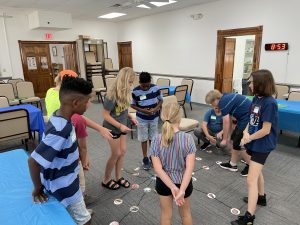
Calhoun County Animal Science Camp Ice-Breaker. What is Agriculture? Summer 2021
comfortable with each other! These types of interactions help build relationships within the group. These are helpful when a group is just starting out, as well as continuing to build bonds overtime. Being deliberate in choosing these types of activities will help any group feel more cohesive. Adjust the activity to suit the group that is participating. Keep it simple for cloverbud age youth (5-7) or add challenges if the group is older or has been together for a period of time. “Ice breakers, get acquainted games, or even roll calls that ask questions about member’s interests (answer roll by making the sound of your favorite animal) can help members get to know each other better.” (Kent, 2015)
- Create a safe space. It may seem easy to create a safe space for youth and other adults but it’s much more difficult in practice! We all think about keeping youth safe physically, but what about the emotional aspect of safety? We must be aware of “microaggressions”, which is defined as a statement, action, or incident regarded as an instance of indirect, subtle, or unintentional discrimination against members of a marginalized group such as a racial or ethnic minority. As a leader, you will want to be able to identify these so you can educate and redirect the situation. It is our job, as adults, to help youth, and other adults, understand the impacts of their words. Creating a shared set of ground rules for everyone to follow can help everyone feel comfortable, knowing the expectations of the group as well as having a voice in creating the space.
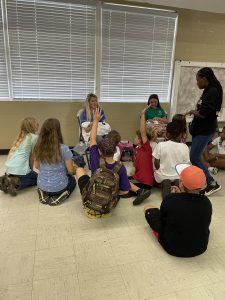
Intro to Animal Handling- Gulf County Summer Camp 2021
- Encourage engagement. Engaging youth members can be done in multiple ways! Various options include using discussion questions, club committees, or even silly ice breaker games – anything constructive to grab and hold their attention. Using discussion questions allows youth to learn from each other while also encouraging a sense of curiosity for life-long learning. Having different committees allows for smaller work groups, which is much less intimidating than a single large group. It is easier for opinions and thoughts to be heard in a smaller setting. Ice breakers may seem silly, but they are a fun and wonderful way to get youth involved.
While a sense of belonging is important for youth, it may take some time and intentionality to create the space to provide the sense of belonging. Our youth members come from all different walks of life and as the adult leader, you must think about the challenges youth may face that makes them different. Some youth may look different physically; some may come from a family that has never done 4-H; some may have experienced trauma; some may have special needs.
A 4-H club, program, or activity can provide a space that youth belong to, as well as allowing them to learn invaluable life skills. Adults, volunteers, and agents are essential to creating this space, while also helping other members see how to increase the sense of belonging for others. What will you do to help make all members feel welcome?
Sources:
https://www.canr.msu.edu/news/essential-elements-of-4-h-belonging
Creating a Welcoming Environment in 4-H Clubs
 Whether you are a teen helping with a day camp, or an adult leading a club- it helps to have some tips and tricks in your back pocket to teach the content you want 4-H members to learn. 4-H volunteers and professionals often find themselves teaching a wide variety of audiences with different needs for learning. Trying to meet all those needs can sometimes seem overwhelming, but this week and next, our blog will focus on six specific strategies that will make this much easier- especially with practice! This blog post will discuss and give examples of three teaching strategies that can up your teaching and facilitation game- spacing, interleaving, and retrieval practice.
Whether you are a teen helping with a day camp, or an adult leading a club- it helps to have some tips and tricks in your back pocket to teach the content you want 4-H members to learn. 4-H volunteers and professionals often find themselves teaching a wide variety of audiences with different needs for learning. Trying to meet all those needs can sometimes seem overwhelming, but this week and next, our blog will focus on six specific strategies that will make this much easier- especially with practice! This blog post will discuss and give examples of three teaching strategies that can up your teaching and facilitation game- spacing, interleaving, and retrieval practice.











